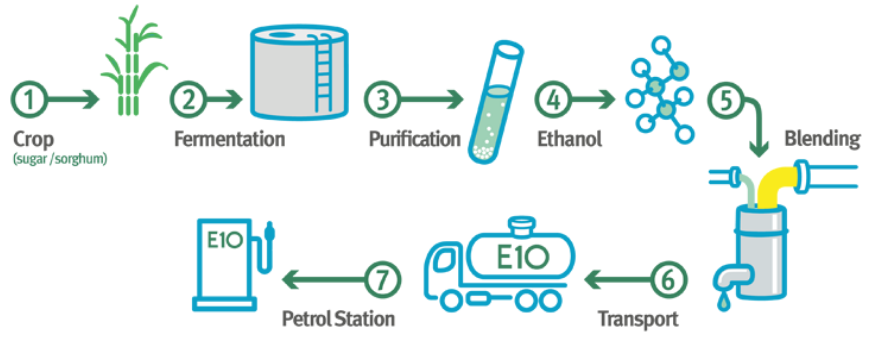Focus: GS III- Environment and Ecology, GS-III: Industry and Infrastructure
Why in News?
The growth of ethanol sector has been tremendous which has set a sort of example for the world, said Shri Piyush Goyal, Union Minister for Consumer Affairs, Food and Public Distribution, Textiles and Commerce and Industry while addressing one day seminar on ‘National Seminar on Maize to Ethanol’ organized by Department of Food and Public Distribution here recently.
What is Ethanol fuel?
- Ethanol fuel is ethyl alcohol, the same type of alcohol found in alcoholic beverages, used as fuel.
- It is most often used as a motor fuel, mainly as a biofuel additive for gasoline.
- Ethanol is commonly made from biomass such as corn or sugarcane.
- Bioethanol is a form of renewable energy that can be produced from agricultural feedstocks.
- It can be made from very common crops such as hemp, sugarcane, potato, cassava and corn.
- There has been considerable debate about how useful bioethanol is in replacing gasoline.
- Concerns about its production and use relate to increased food prices due to the large amount of arable land required for crops, as well as the energy and pollution balance of the whole cycle of ethanol production, especially from corn.

Ethanol Blended Petrol Programme (EBP)
- Ethanol Blended Petrol (EBP) programme was launched in 2003- and this initiative is pursued aggressively in the last 4 to 5 years to reduce import dependence of crude oil as well as mitigate environmental pollution.
- The Ethanol Blending Programme (EBP) seeks to achieve blending of Ethanol with motor sprit with a view to reducing pollution, conserve foreign exchange and increase value addition in the sugar industry enabling them to clear cane price arrears of farmers.
- Although the Government of India decided to launch EBP programme in 2003 for supply of 5% ethanol blended Petrol, it later scaled up blending targets from 5% to 10% under the Ethanol Blending Programme (EBP).
- The Government of India has also advanced the target for 20% ethanol blending in petrol (also called E20) to 2025 from 2030.
- Currently, 8.5% of ethanol is blended with petrol in India.
Roadmap for Ethanol Blending in India by 2025
- The central government has released an expert committee report on the Roadmap for Ethanol Blending in India by 2025 that proposes a gradual rollout of ethanol-blended fuel to achieve E10 fuel supply by April 2022 and phased rollout of E20 from April 2023 to April 2025.
- The Ministry of Petroleum & Natural Gas (MoP&NG) had instituted an Expert Group to study the issues such as pricing of ethanol, matching pace of the automobile industry to manufacture vehicles with new engines with the supply of ethanol, pricing of such vehicles, fuel efficiency of different engines etc.
Advantages of Ethanol Blending
- Use of ethanol-blended petrol decreases emissions such as carbon monoxide (CO), hydrocarbons (HC) and nitrogen oxides (NOx).
- The unregulated carbonyl emissions, such as acetaldehyde emission were, however, higher with E10 and E20 compared to normal petrol. However, these emissions were relatively lower.
- Increased use of ethanol can help reduce the oil import bill. India’s net import cost stands at USD 551 billion in 2020-21. The E20 program can save the country USD 4 billion (Rs 30,000 crore) per annum.
- The oil companies procure ethanol from farmers that benefits the sugarcane farmers.
- Further, the government plans to encourage use of water-saving crops, such as maize, to produce ethanol, and production of ethanol from non-food feedstock.





